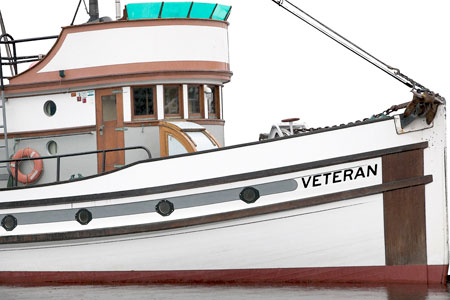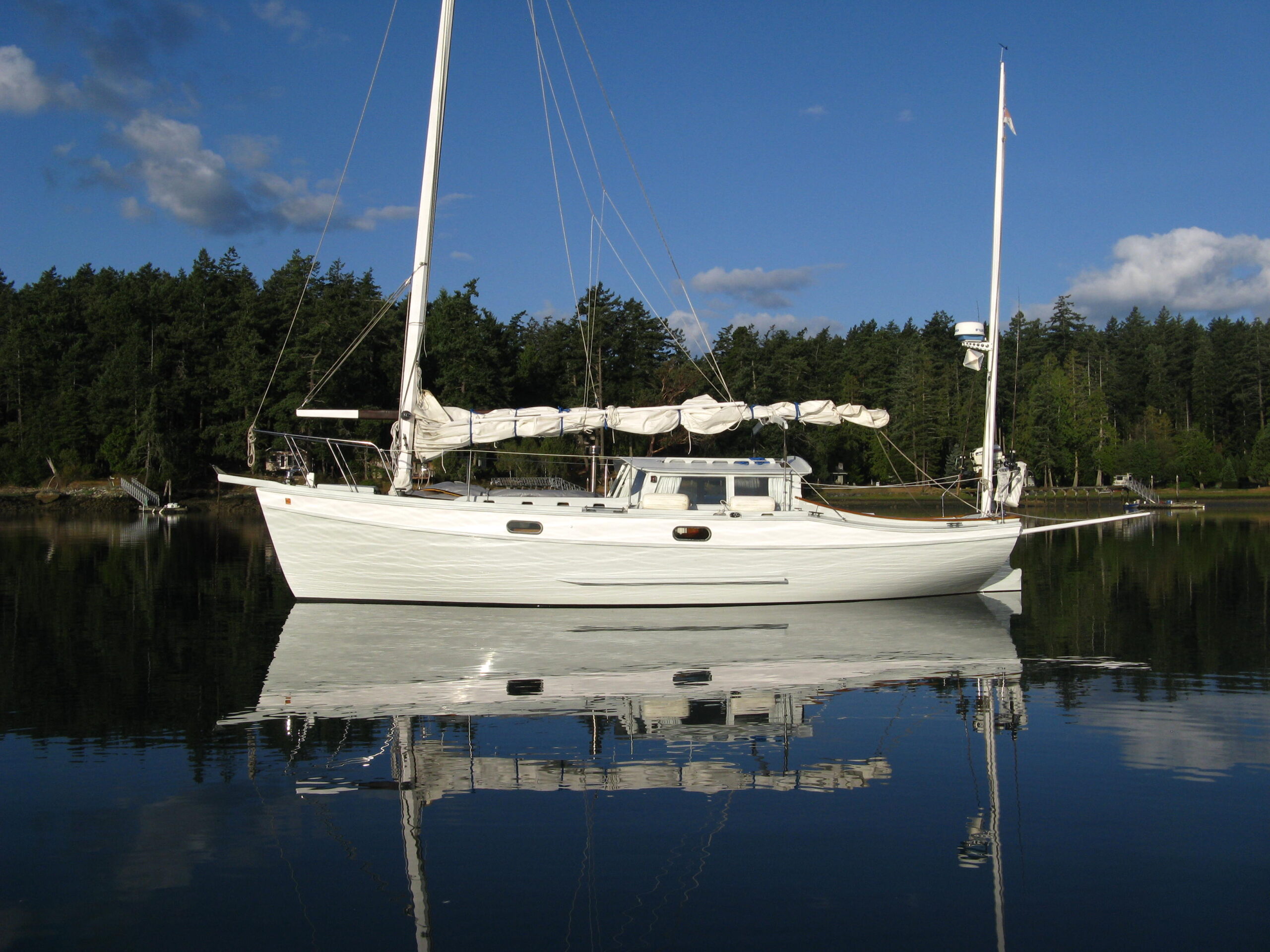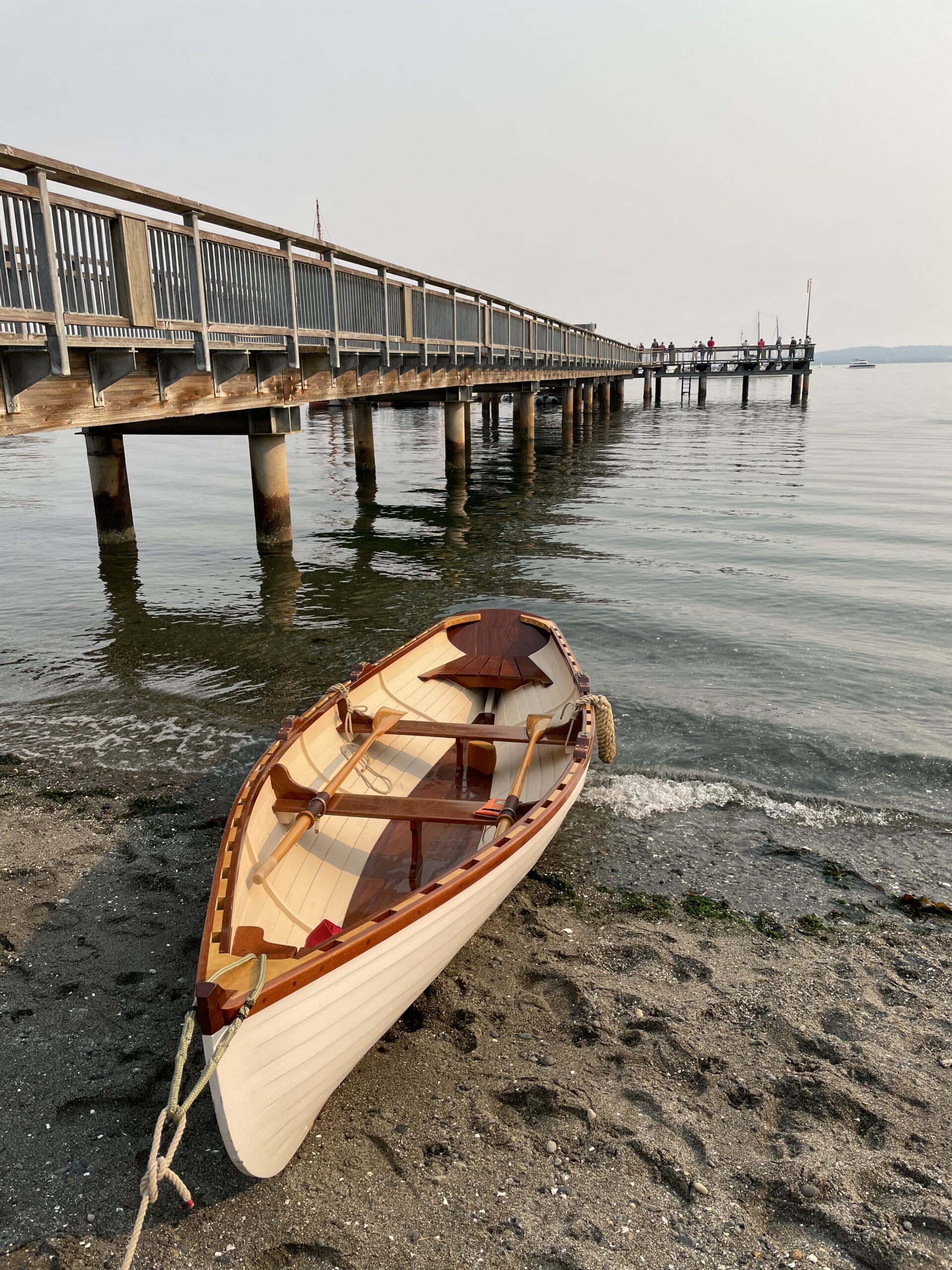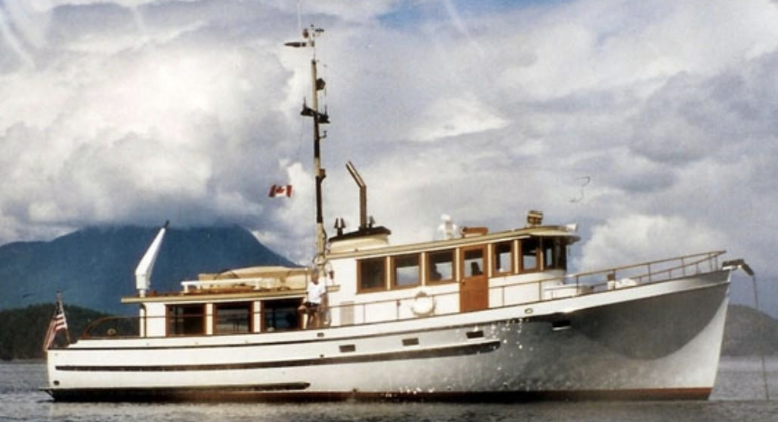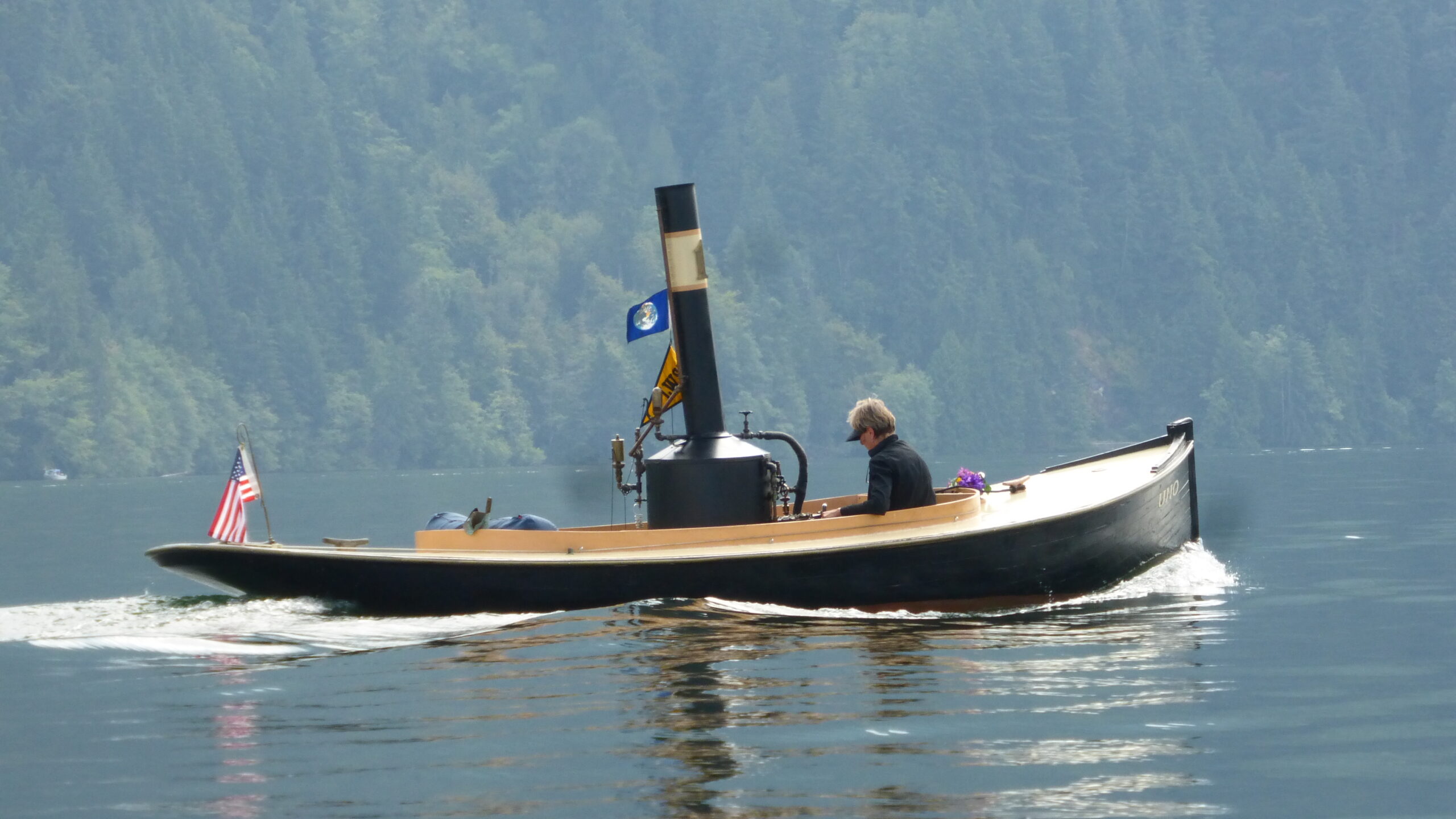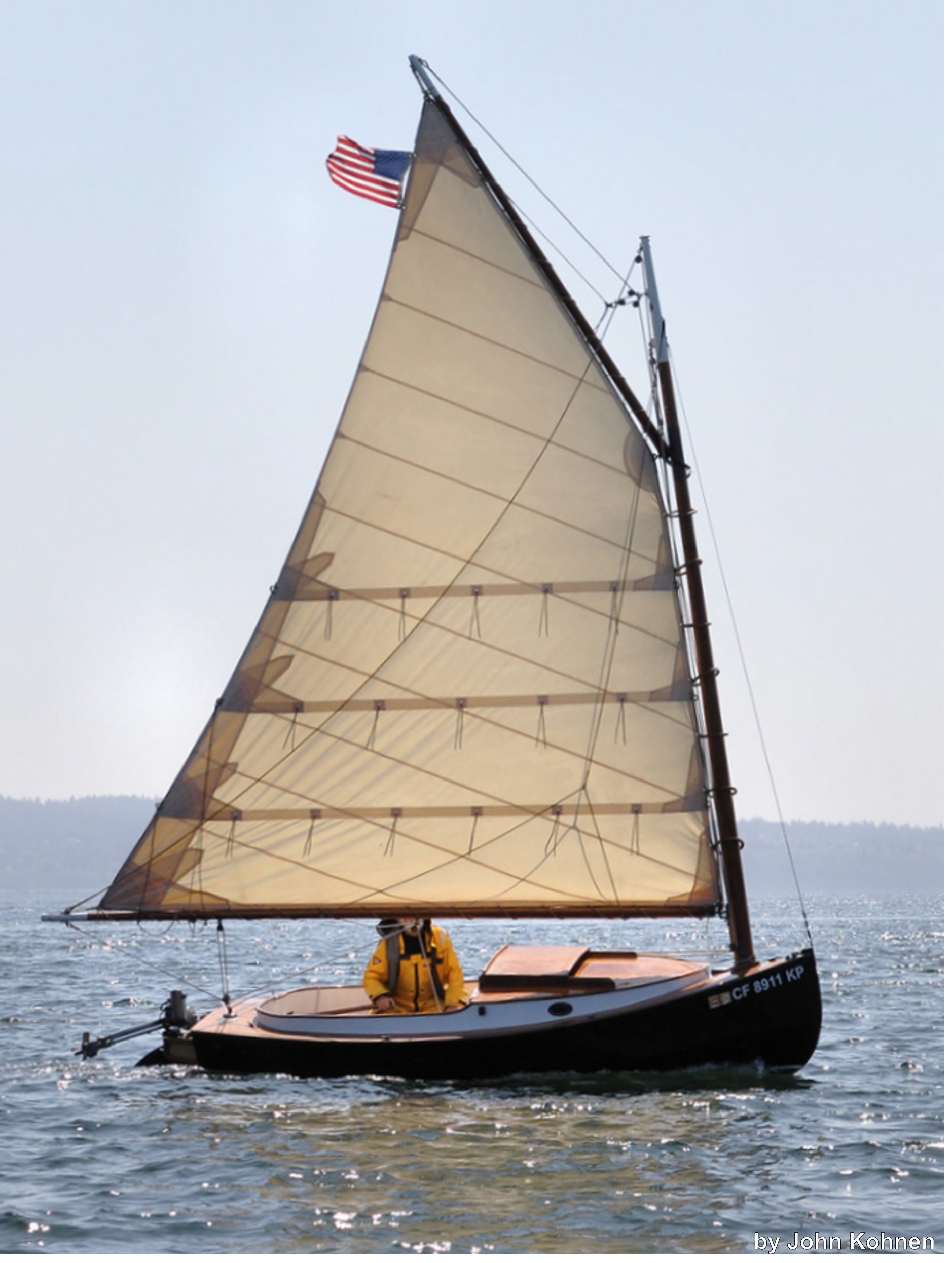
I chose to build a catboat for three reasons. First, I wanted a sailboat with a cabin that would go on a trailer. Slip prices are prohibitive where I live – the San Francisco Bay area. Even if that were not the case, I knew that a wooden boat would require maintenance, which meant I would need to haul her back to the shop occasionally. Catboats get their stability from beam rather than ballast. This means a catboat hull is shallow and relatively light so they slide onto trailers easily. Also, having a boat that lives on a trailer means I can sail where I want rather than where my boat is moored.
Maximizing the use of the space in my shop was my second reason for building a catboat. Like many amateur builders, my shop is a garage. In my case that garage was built for the smaller cars Americans drove in the 1920s. When people comment on the size and proportions of my boat I explain that they are looking at the inside dimensions of that garage. The beam-to-length ratio of a catboat roughly fills my available workspace.
The third reason for my choice goes back to a mistake I made many years ago. My wife and I met when we were teenagers. Young fool that I was, I tried to impress my girlfriend by taking her sailing in the family boat – an International 14. This was in the mid-1960s, back when 14s still resembled what Uffa Fox originally designed rather than the over-canvased surfboards these dinghies have become. Still, our combined weight was far less than the appropriate crew weight for a 14. This meant my future wife learned that sailing was a scary way to get cold and wet. Catboats are supposed to be sailed flat, which I hoped might lure my wife back onto the water with me.
My catboat, named for my wife, is based on Bolger’s Bobcat. The Bobcat is a hard-chine version of the Beetle Cat. My shop is large enough to build a 14 foot hull so I started by scaling up the 12×6 Bobcat to a 14×7 catboat. I wanted a proper tumblehome profile on the bow and a cabin so I changed the forward hull sections accordingly.
I should acknowledge the foolishness of this approach to boat building. Except for stealing some hull sections from the Bobcat, I did not follow an actual plan. There are reasons for naval architects, which I more or less ignored. I do not recommend my seat-of-the-pants approach to boat building. I was lucky to end up with a satisfactory sailboat. The waterline was painted when the hull was still inverted, almost two years before the first launching. I had not done any volume calculations or weight estimates. I simply decided where to paint the waterline by eye. Two years later, when she slid off the trailer for the first time, my catboat floated on those marks as though I knew what I was doing. If I were a complete fool I would attribute that success to skill. In truth I was just lucky. Smart boat builders follow plans.
I used stitch-and-glue technology to build my boat and Sam Devlin’s book (Devlin’s Boat Building) was a big help. So was The Gougeon Brothers on Boat Construction. These two books guided me as I built the hull. I also drew inspiration from Bud McIntosh’s wonderful How to Build a Wooden Boat when building the cabin, hatches, and lockers.
Initially the hull was built inverted for better access to the outer surfaces. Once that water line was painted she was righted and put on a cradle with wheels. This let me push the assembly to one side or the other to increase my working space in that small garage. Sometimes I would roll the cradle out into the driveway to visually check the fairness of the lines. After all, building by eye requires the ability to see what you are doing.
The original Bobcat is planked with 6mm plywood. Except for the bottom panel I used the same plywood thickness for my hull. Probably this was a mistake. Increasing the thickness to 9mm might have avoided a hull breach I had a few years ago when I blew onto some rocks in the Sacramento River Delta. The deck and cabin top are planked with ¼ inch Douglas fir strips over 6mm plywood.
Much of the strength of Bolger’s Bobcat comes from an internal egg-carton structure made up of bulkheads and longitudinal panels. That structure gives the Bobcat hull considerable rigidity. However, it also clutters the space where I wanted to build a cabin. This led to what probably is the most important departure I made from how the Bobcat was built. I retained the bulkhead immediately behind the mast step and the bulkheads behind the cabin. I then used traditional sawn frames in the space defining the cabin. Following the recommendations in Gougeon, I integrated the cabinetry into those frames in order to retain some of the rigidity that would have been provided by the missing bulkheads.
All three spars are hollow and stuffed with aluminum foil. Reportedly this increases my visibility on radar. The rudder might be oversized but it solves a big problem most traditional catboats have. When running downwind, catboats develop a strong weather helm because their long booms place the center of the sail area far outboard. This problem is aggravated in strong winds with a following seas. Those conditions can momentarily lift a shallow barndoor rudder out of the water resulting in a broach. I have seen this happen several times when running downwind with other catboats. Because my rudder is so large and deep, that has never happened to me.
Originally I sailed without a motor. There is great satisfaction to be derived from meeting the challenge of making your way to a destination by using only the available wind and currents. It’s also quieter. That challenge lost its charm for me the year I found myself becalmed in the middle of the Straits of Juan de Fuca. I now carry a British Seagull as an auxiliary. The Seagull I use is heavily modified, but the core parts were made the year before I was born. Many people mistakenly think I choose a Seagull because it is a cool looking antique. In truth what appeals to me is the simplicity of this engine. With the appropriate Whitworth wrenches and the small collection of spare parts I carry on board I can fix almost anything that can go wrong. Of course, things do go wrong. After the sail-by on the last day of the Festival one year my Seagull refused to start. While bobbing around on Port Townsend Bay, I fixed the problem by replacing the carburetor. I certainly would prefer an outboard that never broke down, but I cannot believe that such a miracle actually exists.
So how has this foolishly “owner-designed” boat worked out? I certainly made a lot of mistakes. Besides letting the rudder extend beyond the protection of the skeg, the cockpit lockers have no gutters and drain into the bilge rather than the self-draining cockpit. However, the building process certainly provided the distraction I needed during a difficult point in my career. The resulting boat sails well, has held up to some very demanding conditions, and carried me to places of sublime beauty. I considered this build to be one of my favorite accomplishments.
But did it address that third goal and lure by muse back onto the water? Not exactly. I do have a cute photo showing the two of us together in that cozy berth. However, that photo suggests a lie. The original Jean Alden will sail with me on her namesake. But that is mostly because she is a very good sport. Jean would much rather spend her time on the water rowing the small skiff I built for her. The story of that skiff is another tale.

